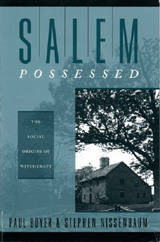Review: Salem Possessed - The Social Origins of Witchcraft, by Paul Boyer & Stephen Nissenbaum
Okay, so that goes without saying, really, I mean...it was a Florida public school and the fact that I made out with any kind of basic knowledge of anything should be a credit to the individual teachers, as well as my own passion for learning (since, if either I or my teachers had gone by the recommended curriculum of the day, I would have never made it back out of Florida). But still, I feel like I was gypped.
In my high school (which was, and still is, an arts magnet school), the theatre kids had English and Theatre classes back to back so as to keep certain lessons and certain projects in tandem and consistent. As a result, sometimes the lines between fact and literary fiction would get a little blurred. And it's not as if our 11th grade American History teacher did anything to help that. I've said this before - some of those teachers didn't know anything outside of the basic curriculum, so we got screwed.
Anyway, in our theatre-oriented English class we read a ton of New England drama/poetry (in preparation for our annual trip) and we read The Crucible by Arthur Miller (which takes the facts of the Salem Witch Trials of 1692, runs them through a rinse cycle, and lays them out flat to dry into a metaphor for the McCarthy hearings). (Prior to that, I had read Kathryn Lasky's Beyond the Burning Time which explores a lot of the themes that are historically established in Boyer and Nissenbaum's history, but I had read it as summer reading prior to freshman year of high school so there was a test on it, but it was never discussed). That same year, we took the annual bus ride up to the north east, visited Walden Pond, Sleepy Hollow Cemetery and Salem, Mass.
Even modern day Salem seems to be in on the trickery. They have the name, so they have the fame - even though Salem Village (where the drama really took place) eventually became Danvers, Mass with just a little bit of overlap into Salem Town. And in the spirit of capitalizing on their witch-themed merchandise and ghost tours, they don't really tell you any different. They don't mention that most of the turmoil leading up to the accusations came from a split in the community - half wanting to maintain their membership in Salem Town and explore their commercial options, half wanting to segregate themselves and become independent of the very town that now hosts explosions of tourism every Halloween season.
Don't get me wrong - I love Salem. I've been back since that high school trip, and I've loved every second of it. I've done the ghost tours, I've shopped the mystical shops, I love the atmosphere that town has in October. But I feel like knowing what I SHOULD have known then, I'm disappointed. I'm excited to go again having all of this information and revisiting my experiential opinion of the place, but I wish I had had the real history, before.
Boyer and Nissenbaum have done their research. The book may be a few decades old, but with a topic that's now over 300 years old, a few decades doesn't make a lot of difference. Their exploration into the financial logistics of Salem Village's situation in the 17th century is a little boring at times, but their explanation of the divisions within the community between the Putnams and the Porters, on the side for or against Rev. Parris, and between Village and Town is remarkable. Sometimes I have to kick myself to remind me that people actually kept personal records in the 1600s and they had some of the same problems we have today (and not wholly plebeian, as I so often mistakenly think).
The facts are good, but on that same token, Boyer and Nissenbaum seem to lay aside any concerns from the religious standpoint. In the 17th century, with religion being the way it was, witchcraft was a scientific plausibility. Forget the social aspect of it - the idea of a witch/wizard/devil appearing in specter form to a victim was a rational concept! It wasn't JUST the socioeconomic situation that drove these trials to the head that they reached, it was the belief that such things could truly be.
Today, you need a video camera and a television or a projector with a screen to accomplish what the "afflicted" claimed they saw in 1692. Throw in the pinching and tormenting, and you just need to actually be present, screw technology. But that seems to be left out of Boyer and Nissenbaum's scope of understanding. They leave out half of the psychological impetus and that, to me, makes it an incomplete narrative. Seems to me, if you're going to lay a claim of understanding of the "social origins" of anything, it shouldn't just be the monetary end of that understanding.


Comments
Post a Comment
Any and all feedback is welcome - thanks for taking the time!